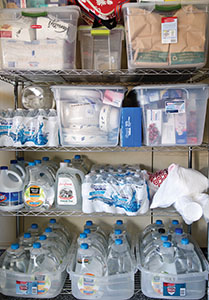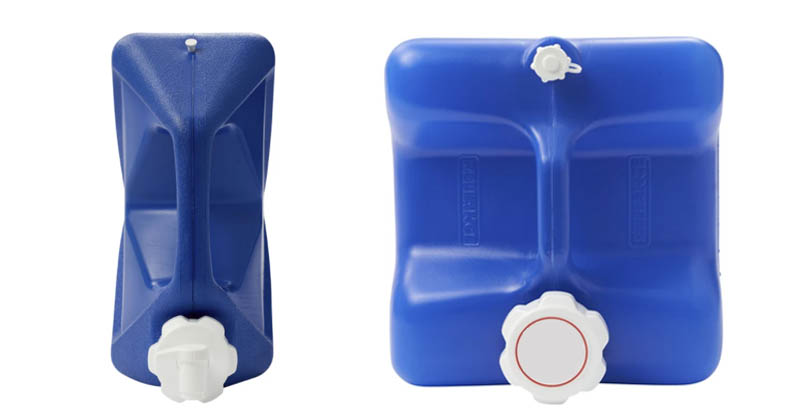The recent water crisis in California has people all over America talking about how to be prepared in case of an emergency. Unfortunately, most of these conversations focus more on food than water!
That’s weird because we live in a society that seems obsessed with drinking alcohol and eating junk food. I mean, just look at the commercials; it’s like they know what will make you thirsty and hungry!

Fortunately, water is pretty cheap (compared to buying beer or chocolate chip cookies) so if you are really concerned about having enough to survive, there are some simple rules of thumb that can help.
This article will tell you three easy ways to determine how much water you should have for an emergency situation.
How much water should you store for an emergency?
Emergency water storage is one of the most important parts of being prepared for an emergency. But how much water should you store?
The answer to that question depends on a number of factors, including the size of your family, the climate you live in, and the type of emergency you’re preparing for.
In general, it’s recommended that you store at least 1 gallon of water per person, per day. That means, for a family of four, you should have at least 4 gallons of water stored.
Of course, if you live in a hot climate or if you’re preparing for a prolonged emergency, you’ll need to store more water.
The best way to determine how much water you need to store is to use the rule of 3s.
The rule of 3s says that you should have 3 days worth of water for each person in your family. So, for a family of four, you would need to store 12 gallons of water.
Of course, you may not be able to store that much water all at once. In that case, you’ll need to ration your water.
To do that, you’ll need to know how much water your family uses on a daily basis. A good rule of thumb is to assume that each person uses about 2.5 gallons of water per day.
So, for a family of four, you would need to ration 10 gallons of water over a three-day period.
Of course, this is just a general guideline. Your water needs will vary depending on the size of your family, the climate you live in, and the type of emergency you’re preparing for.
But by following the rule of 3s, you’ll be sure to have enough water stored to get your family through an emergency.
Water storage containers for your water needs
When it comes to water storage, there are a lot of options out there. But which one is right for you?
Here’s a look at some of the most popular water storage containers on the market, so you can make the best choice for your needs.
1. Water Storage Barrels
Water storage barrels are a great option for those who need to store a lot of water. They’re typically made of plastic or metal and can hold up to 55 gallons of water.
2. Water Storage Tanks
Water storage tanks are a good option for those who need to store a large amount of water but don’t have the space for a water storage barrel. Tanks can hold up to 1,000 gallons of water.
3. Water Storage Containers
Water storage containers are a good option for those who need to store a small amount of water. They’re typically made of plastic or metal and can hold up to 5 gallons of water.
4. Water Storage Bags
Water storage bags are a good option for those who need to store a small amount of water. They’re typically made of plastic or metal and can hold up to 3 gallons of water.
5. Water Storage Jugs
Water storage jugs are a good option for those who need to store a small amount of water. They’re typically made of plastic or metal and can hold up to 1 gallon of water.
When it comes to water storage, there are a lot of options out there. But which one is right for you? With so many options available, it can be tough to decide. But if you take the time to figure out what your needs are, you can find the perfect water storage solution for you.
When to take it
Having enough water is always important, but there are times when having an adequate supply becomes even more significant. One example of this is during a natural disaster or emergency situation when people are asking you how much water you have!
Urgent needs can make it hard to focus on other things, like making sure you’re hungry and/or thirsty. So, before these questions start piling up, know what your average daily intake is so that you don’t need to worry about it.
Fortunately, our staff at HealthEquals has done some research and prepared a little checklist for you to refer to. This list includes numbers for both men and women. (Warning: may contain slight drinking references)
So, here you go! Read on to find out exactly what each number means as well as how to use this information in an actual crisis.
When to share
There is never an appropriate time to tell someone they have to go outside due to a natural disaster or emergency situation, but water is one thing you can make sure everyone has.
If people are sharing their glass bottles, that’s great! Keep giving them out, however, and try to get some from different sources — most places will give away free water if you ask.
At least two people in your community should be able to use at least a couple of gallons every day, so pull up the supply and see who could use it before you hand it over.
Everyone else should be able to grab a few drops too, even if you don’t feel like giving them all of yours. It’ll help prevent mental health issues and keep them hydrated, which is important.
How to keep it safe

While there is no universal recommendation for how many gallons of water you should have, we can tell you what the experts recommend. The National Fire Protection Association (NFPA) says that everyone must have at least one full glass per person per day to ensure adequate hydration during an emergency.
This helps your body process food and drink more efficiently, which are both essential in the long run. Standard bottle size is two glasses, which is enough for most people.
Experts also suggest having three additional bottles at all times – one for each member of the family. These do not need to be expensive brands, but they should be known as being sturdy and trustworthy.
These bottles should always be labeled with your name so that you will know what content belongs to who. This way, if someone loses their own supply, you still have a backup.
Hydration is important
Having enough water is very crucial in preventing death during an emergency situation. If your house has been ravaged by a natural disaster, looting has occurred or you need to shelter in place because of COVID-19, then finding food and water becomes more difficult as time goes on.
Fortunately, we have some hard numbers that tell us how much water you should be drinking per day depending on your body size. By knowing this information, you can start today!
We also have numbers telling us how many gallons of water you should have on hand at all times in case of an emergency. Luckily, these numbers decrease as the day goes on! This article will help you determine which one is most relevant for you.
Water breaks down your body
Even water can do great things to you, breaking down into oxygen and hydrogen atoms and then re-forming elsewhere in your body.
That’s why after an earthquake or flood people are advised to take at least one drink of plain water per person every hour until they get professional help.
After six hours, half of the fluid will be gone, and most adults have enough sense to recognize that they should look for help sooner rather than later.
But what if you don’t know how to handle your own internal chemistry? What if you’re not sure whether you need more acid or base?
Drinking too much liquid can be disastrous unless you know which liquids work and don’t work when there’s an emergency.
Know your symptoms
Knowing what to do in an emergency situation is very important, but knowing how much water you should have per person is even more crucial. Different situations require different amounts of water!
In this article, we will go over some common emergencies that can call for an urgent need for hydration, as well as what numbers our government recommends as the ideal amount for each person.
First things first, make sure to check out our list here about how to survive a disaster. The number one rule is SURVIVE, so whether it’s a natural or man-made disaster, your top priority should be staying alive.
After that, looking at recommendations for water needs is a great next step. Government agencies publish these guidelines to help people stay informed during an emergency.
These water needs assessments are really helpful when it comes to figuring out how many gallons of water everyone should have while seeking rescue or helping others.

Do not rely on water
Even though it’s tempting to drink as much water as you can, doing so could be disastrous in some cases. Drinking too much liquid may actually prevent your throat from drying out, which could impair your ability to breathe and speak.
In fact, drinking more than 15 cups of water per day is associated with diarrhea, both infectious and non-infectious. Diarrhea removes important fluids and minerals from your body and can contribute to dehydration and fatigue.
Keep a kit
Having enough water is obviously important, but how much you need really depends on what kind of emergency you are facing and when. Unfortunately, most pre-made kits do not include an appropriate amount of water for unexpected situations!
Most people have heard of “survival” or “emergency” gear that includes at least a one-month supply of food and one gallon of water per person. While it is great to know about these guidelines, they are very hard to find and manage during a crisis.
In fact, many experts suggest having three days’ worth of supplies at all times.
If you cannot find an answer on our website to your question, feel free to message or call us!
